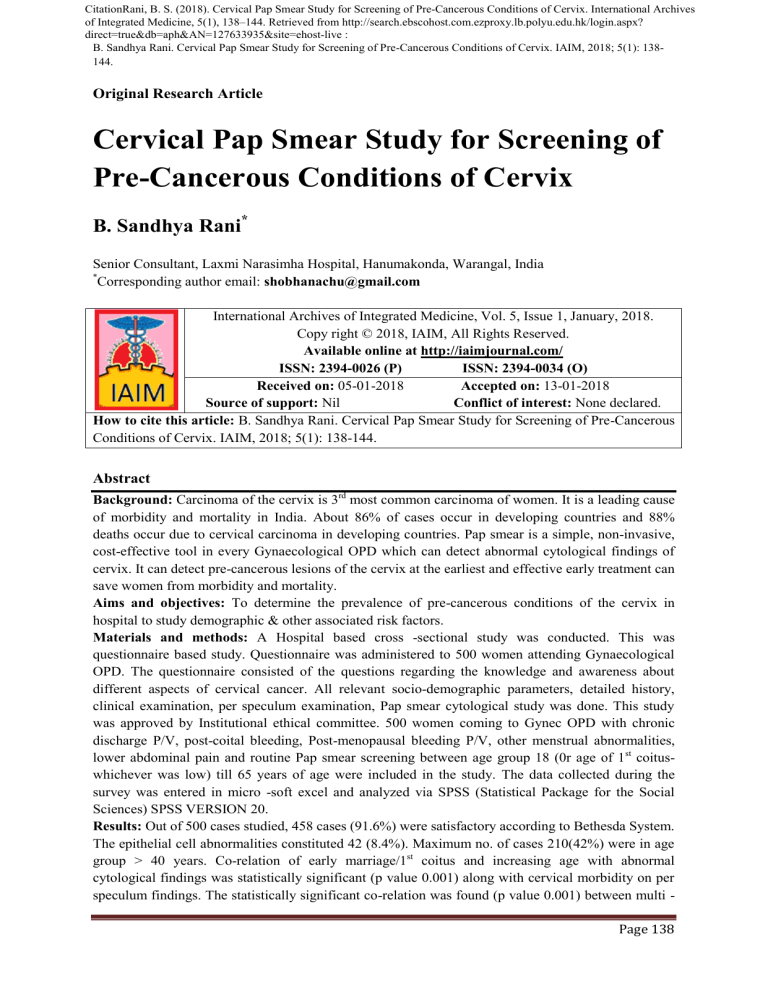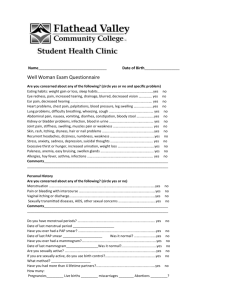
CitationRani, B. S. (2018). Cervical Pap Smear Study for Screening of Pre-Cancerous Conditions of Cervix. International Archives
of Integrated Medicine, 5(1), 138–144. Retrieved from http://search.ebscohost.com.ezproxy.lb.polyu.edu.hk/login.aspx?
direct=true&db=aph&AN=127633935&site=ehost-live :
B. Sandhya Rani. Cervical Pap Smear Study for Screening of Pre-Cancerous Conditions of Cervix. IAIM, 2018; 5(1): 138144.
Original Research Article
Cervical Pap Smear Study for Screening of
Pre-Cancerous Conditions of Cervix
B. Sandhya Rani*
Senior Consultant, Laxmi Narasimha Hospital, Hanumakonda, Warangal, India
*
Corresponding author email: shobhanachu@gmail.com
International Archives of Integrated Medicine, Vol. 5, Issue 1, January, 2018.
Copy right © 2018, IAIM, All Rights Reserved.
Available online at http://iaimjournal.com/
ISSN: 2394-0026 (P)
ISSN: 2394-0034 (O)
Received on: 05-01-2018
Accepted on: 13-01-2018
Source of support: Nil
Conflict of interest: None declared.
How to cite this article: B. Sandhya Rani. Cervical Pap Smear Study for Screening of Pre-Cancerous
Conditions of Cervix. IAIM, 2018; 5(1): 138-144.
Abstract
Background: Carcinoma of the cervix is 3rd most common carcinoma of women. It is a leading cause
of morbidity and mortality in India. About 86% of cases occur in developing countries and 88%
deaths occur due to cervical carcinoma in developing countries. Pap smear is a simple, non-invasive,
cost-effective tool in every Gynaecological OPD which can detect abnormal cytological findings of
cervix. It can detect pre-cancerous lesions of the cervix at the earliest and effective early treatment can
save women from morbidity and mortality.
Aims and objectives: To determine the prevalence of pre-cancerous conditions of the cervix in
hospital to study demographic & other associated risk factors.
Materials and methods: A Hospital based cross -sectional study was conducted. This was
questionnaire based study. Questionnaire was administered to 500 women attending Gynaecological
OPD. The questionnaire consisted of the questions regarding the knowledge and awareness about
different aspects of cervical cancer. All relevant socio-demographic parameters, detailed history,
clinical examination, per speculum examination, Pap smear cytological study was done. This study
was approved by Institutional ethical committee. 500 women coming to Gynec OPD with chronic
discharge P/V, post-coital bleeding, Post-menopausal bleeding P/V, other menstrual abnormalities,
lower abdominal pain and routine Pap smear screening between age group 18 (0r age of 1st coituswhichever was low) till 65 years of age were included in the study. The data collected during the
survey was entered in micro -soft excel and analyzed via SPSS (Statistical Package for the Social
Sciences) SPSS VERSION 20.
Results: Out of 500 cases studied, 458 cases (91.6%) were satisfactory according to Bethesda System.
The epithelial cell abnormalities constituted 42 (8.4%). Maximum no. of cases 210(42%) were in age
group > 40 years. Co-relation of early marriage/1st coitus and increasing age with abnormal
cytological findings was statistically significant (p value 0.001) along with cervical morbidity on per
speculum findings. The statistically significant co-relation was found (p value 0.001) between multi Page 138
B. Sandhya Rani. Cervical Pap Smear Study for Screening of Pre-Cancerous Conditions of Cervix. IAIM, 2018; 5(1): 138144.
parity (40.7%) and abnormal cervical smear findings. ASCUS was (5.4%) followed by LSIL (1.4%),
HSI L (0.8%) and SCC (0.8%).
Conclusion: The study clearly shows relatively high prevalence of epithelial abnormalities in cervical
Pap smear with increasing age, parity and early age at first coitus in symptomatic women with clinical
lesions on per speculum findings. Effective screening with Pap smear definitely helps in early
detection of Precancerous lesions of cervix Effective, frequent Pap smear screening programmes
should be organised in India, even in the remotest rural areas to prevent the incidence of invasive
cervical carcinoma.
Key words
Pap smear screening, Cervical cancer, Cytology.
Introduction
Carcinoma of the cervix is one of the most
common carcinoma among women worldwide
[1], most frequent carcinoma in women in India
[2]. It is also the most common cancer in women
in many parts of the world including southcentral Asia [1]. It has been the most important
carcinoma in women in India constituting 1130% of all cancers in women and has become the
leading cause of mortality and morbidity [3].
About 86% of cases occur in developing
countries and about 88% deaths occur due to
cervical cancer in developing countries [4]. Risk
factors include persistent infection with high risk
strains of Human Papilloma virus, other risk
factors include early age at marriage, multi parity, less spacing between pregnancies, low
socio-economic status, prolonged use of oral
contraceptives and smoking [5].
Women in developing countries usually present
to the clinic only when they have symptoms such
as pain, discharge P/V, and/ abnormal bleeding
P/V [6]. The risk of cervical cancer remains high
in many developing countries usually due to lack
or
inefficiency of existing preventive
programmes. To detect abnormal precancerous
cells in cervix, before patients get any symptoms,
a very simple, non-invasive, cost-effective test
for mass screening is used named as
“Papanicolaou (Pap) smear test. It is used for the
diagnosis of cervical precancerous and cancerous
lesions [7]. Screening of women coming to
routine Gynaecological OPD with symptoms of
Pain, vaginal discharge, abnormal bleeding, If
subjected to Pap smear screening, by Bethesda
System 2001 [8], will go a long way in terms of
lives saved and cancer of cervix prevention.
Early detection of epithelial abnormalities helps
in early treatment of dysplastic epithelial changes
(CIN1 to CIN III), can prevent invasive cervical
carcinoma.
Aim and objectives
To determine the prevalence of
precancerous conditions of cervix ( CIN
I- III )in women with chronic vaginal
discharge and sexually active women by
screening with Pap smear in hospital
based
To find out detection rate of epithelial
abnormalities of cervix
To find out associated risk factors related
to age, age at marriage/1st coitus, parity,
spacing of children, socio-economic
status and per speculum findings.
Materials and methods
The study was conducted in the department of
Obstetrics and Gynecology. This study had been
approved by the ethical committee of the
institution. The study was a cross-sectional
study, comprising of 500 women in age group of
18 (or age of 1st coitus-whichever was low) -65
years, coming to Gynaecological OPD, who were
sexually active and with symptoms of chronic
vaginal discharge, or Post-coital bleeding P/V, or
Inter-menstrual bleeding P/V, or lower
abdominal pain and women with no complaints
but for routine cancer screening. Purpose of the
Page 139
B. Sandhya Rani. Cervical Pap Smear Study for Screening of Pre-Cancerous Conditions of Cervix. IAIM, 2018; 5(1): 138144.
study was explained to the patients and informed
written consent was taken. This was
questionnaire based study. Questionnaire was
administered to 500 women attending
Gynaecological OPD. The questionnaire
consisted of the questions regarding the
knowledge and awareness about different aspects
of cervical cancer. Detailed findings including
age, Gravida /para, space between children,
prolonged use of oral contraceptives, smoking,
age at marriage/ 1st coitus, marital status, socioeconomic status, detailed clinical & menstrual
history, Post-coital bleeding, vaginal discharge,
per speculum clinical examination, were
recorded on the pre-designed, pre-structured
proforma. After doing per speculum examination
with cusco’ s speculum, Cervical scrape smears
were collected using Ayer’s spatula and
endocervicalbrush Cervical scrapings were
spread on a glass slide and dipped in Ethanol
solution container. Pap smears of all the patients
were collected and sent to pathology dept. The
smears were stained using Papanicolaou method.
The cytological abnormalities were classified
according to The Bethesda System 2001 by the
pathologist after examining Pap smears.
Data analysis
Data was analyzed using SPSS Version 20 (IBM,
Chicago, U.S.A). To find out the association
between attributes, Chi- Square test was applied
and p value of <0.05 was considered to be
statistically significant.
Results
500 women attending Gynaecology OPD were
subjected to cervical Pap smear during the study
period. It was found that out of 500 cases
studied, 458 cases (91.6%) were satisfactory
according to Bethesda System. The epithelial cell
abnormalities constituted 42 (8.4%) of all cases.
Maximum no. of cases 210 (42%) were in age
group of more than 40 years, followed by age 1825 years 84 (16.8), 30-35 years 71 (14.2%), 3640 years 67 (13.4%), 26-30 years 58 (11.6%).
The Epithelial abnormalities included 8.4% of all
cases out of which ASCUS (atypical squamous
cells of undetermined origin) was 5.4%, followed
by LSIL (low squamous intra-epithelial lesion)
1.4%, followed by HSIL (high squamous intraepithelial lesion) 0.8% and SCC (squamous cell
carcinoma) (0.8%). Most common age group
affected by ASCUS was > 40 years of age. 2
patients showed SCC at age 31-35 years. Out of
458 normal cases, 151 were detected with
cervical erosion or cervicitis. There were 42
abnormal smears out of which ASCUS (27) was
most common.
Table - 1: Socio demographic profile of the
participants.
Age group (Years)
N
%
<18
10
2%
18-25
84
16.8%
26-30
58
11.6%
31-35
71
14.2%
36-40
67
13.4%
>40
210
42%
Age at marriage
N
%
<18
44
8.8%
18-25
417
83.4%
26-30
33
6.6%
>30
6
1.2%
Age at first coitus
N
%
<18
46
9.2%
18-25
430
86%
26-30
19
3.8%
>30
5
1%
Total
500
100%
The frequency of dysplasia and cervical
carcinoma in relation to age is shown in Table 1. The progressive rise in epithelial abnormalities
was seen with increasing age and maximum
frequency was seen in age > 40 years. Age at
first coitus was calculated and it showed 86%
women were of age group.(18-25) years, 9.2%
(<18 years), 3.8% in (26-30)years with just 1%
in >30 years. Relationship of early marriage/1st
coitus, with cervical morbidity showed clearly
that it has significant influence (p value < 0.001)
on cervical morbidity. Symptoms were
maximum as discharge P/V (30%), pain lower
abdomen (25.6%), pruritits vulva (11.6%), postPage 140
B. Sandhya Rani. Cervical Pap Smear Study for Screening of Pre-Cancerous Conditions of Cervix. IAIM, 2018; 5(1): 138144.
coital bleeding (5.6%), post-menopausal
bleeding
(5.2%),
menorrhagia
(4.6%),
Dysparunia (2.6%), Infertility (0.6%) Maximum
P/S findings were of cervical erosion/ cervicitis
(83.2%) in 18-25 age group followed by < 18
years. 8.8%. It showed that more the no of years
of coitus, more the risk of cervical morbidity.
Table – 2: Type of reproductive tract morbidity.
Symptom
N
%
Discharge PV
150
30%
Pain lower abdomen
128
25.6%
Pruritis vulva
58
11.6%
Post-coital bleed
18
3.6%
Discharge PV + Pain 78
15.6%
lower abdomen
+ Post-coital bleed
Menorrhagia
23
4.6%
Post-menopausal
26
5.2%
bleed
Primary infertility
3
0.6%
Dyspareunia
13
2.6%
Something coming 2
0.4%
out from vagina
Any other
1
0.2%
Total
500
Relationship of parity with abnormal Pap smear
was analysed and it was found that multipara (4
or >4 children) were having maximum cervical
morbidity (40.7%) followed by women with 3
children (18.75%), women with1- 2 children
(11.8%) Parity is also proved to be statistically
significant (p value <0.001). In the study group,
as only 3 women were smokers, the association
of smoking with dysplasia could not be
predicted. All 500 women were classified
according to Kuppuswamy classification into
upper, middle, lower class. Prevalence of
cervical dysplasia was higher in low socioeconomic group but it was not statistically
significant.
Table - 1 depicts the socio demographic profile
of the participants. Maximum number of study
subjects belonged to the age group of >40 years.
Majority of the participants got married in at the
age of 18 - 25 years. Similarly the age of first
coitus was maximum in the same age group i e.
18-25 years.
Table – 2 represents the type of reproductive
tract morbidity among study subjects. Discharge
per vaginum was the commonest complaint
(30%) followed by symptoms like pain lower
abdomen (25.6%).
Table - 3 shows the relationship of age at
marriage and parity with the cervical morbidity
among the study subjects. Most common per
speculum finding found in all the age groups was
cervical erosion or cervicitis which was prevalent
commonly between the age group of 18-25 years.
Early Age at 1st coitus has significant (p value
<0.001) influence on cervical morbidity.
Similarly parity is also significantly (p value <
0.001) associated with type of cervical
morbidity. As the parity increases, cervical
morbidity is also on rise.
Table - 4 shows the distribution of types of
dysplasia. Most common pap smear lesion was
ASCUS followed by LSIL.
Table - 5 shows distribution of dysplasia as per
age groups. Most common histopathological
lesion found in all the age groups was ASCUS
followed by LSIL and HSIL and SCC. The most
common age group affected by ASCUS was
the>40 years of the age study subjects.
The Figure - 1 shows the different types of
dysplasia detected by the pap smear as per the
clinical findings during the per speculum
examination. Out of 458 normal cases, 151 were
detected with cervical erosion or cervicitis. There
were 42 abnormal smears out of which most
common was ASCUS (27).
Discussion
The current study was carried out among 500
females attending Gynec OPD at a tertiary care
centre. (PIMS) Most patients belonged to the age
of 18 - 25 years. Majority of the participants got
Page 141
B. Sandhya Rani. Cervical Pap Smear Study for Screening of Pre-Cancerous Conditions of Cervix. IAIM, 2018; 5(1): 138144.
married in at the age of 18 - 25 years and the age
of first coitus is maximum in the same age group
i .e. 18-25 years. The study shows that most
common reproductive morbidity was discharge
per vaginum (30%) followed by pain lower
abdomen (25.6%). Similar findings were
reported by Sharma P, et al. (2010) in a
Community Based Study on cervical cancer
screening program among women of Delhi. The
most common reproductive tract morbidity in
their study was discharge per vaginum (28.5%)
followed by pain lower abdomen (20.1%). Other
complaints were post- coital bleeding, inter menstrual bleeding, something coming out of
vagina, menorrhagia, dyspareunia, pruritis vulva
etc. [9]. These could be attributed to poor
personal hygiene. These observations were
further supported by Desai M, et al. (2004) in
Community Based Cancer Screening Program in
Vadodara [10].
Table – 3: Relationship of age at marriage and parity with cervical morbidity.
Age at
Normal
Erosion/
Hypertrophy Atrophy
marriage
cervicitis
<18
29 (17.4%)
12(5.85%)
2 (2.27%)
1 (2.43%)
18-25
123 (74.09%)
175 (85.36%)
82 (93.18%)
37 (2.43%)
26-30
12 (7.22%)
16 (7.80%)
3 ( 3.04% )
2 (4.87%)
>30
2 (1.20%)
2 (0.97%)
1 (1.13%)
1 (2.43%)
Parity
0
9 (37.5%)
10 (4.34%)
50 (30.86%)
1(1.85%)
1
7 (29.16%)
10 (4.34%)
48 (25%)
2(3.7%)
2
4 (16.6%)
12 (5.21%)
40 (20.83%)
3(5.55%)
3
2 (8.33%)
47 (20.43%)
36 (18.75%)
9(16.65%)
4
1 (4.16%)
60 (26.08%)
10 (6.17%)
17(31.45%)
>4
1 (4.16%)
91 (39.56%)
8 (4.16%)
22(40.7%)S
Total
P
value
44(8.8%)
417(83.2%)
33 (6.6%)
6 (1.2%)
P
<0.001
70 (14%)
67(13.4%)
59(11.8%)
94(18.8%)
88(37.6%)
122(24.4%)
P
<0.001
Table – 4: Types of cervical dysplasia among study subjects.
Cytological examination
Normal
ASCUS
LSIL
HSIL
SCC
Total
N
458
27
07
04
04
500
Percentage
91.6%
5.4%
1.4%
0.8%
0.8%
100 %
Table – 5: Distribution of dysplasia as per age.
Age group
<18
18-25
26-30
31-35
36-40
>40
Total
Normal
10
80
54
65
62
194
465
ASCUS
0
4
4
3
3
13
27
LSIL
0
0
01
01
02
03
07
HSIL
0
0
0
01
01
02
04
SCC
0
0
0
2
1
1
04
Total
10
84
58
71
67
210
500
Page 142
B. Sandhya Rani. Cervical Pap Smear Study for Screening of Pre-Cancerous Conditions of Cervix. IAIM, 2018; 5(1): 138144.
Figure - 1: Different types of dysplasia as per clinical findings.
The present study revealed that most common
per speculum finding found in all the age groups
was cervical erosion or cervicitis (41%) and most
common affected age group was 18-25 years.
Age played a significant (p value <0.001) role in
determining the type of cervical morbidity.
Similarly parity was also significantly (p value <
0.001) associated with type of cervical
morbidity. These findings were supported by
Khamankar ST, et al. (2014) in a study
conducted on risk factors for cervical neoplasia
among rural women of Maharashtra as in their
study also, factors like age and parity were
significantly associated with cervical neoplasia.
In their study, age and high parity were observed
to be the risk factors for cervical neoplasia on
pap smear [11]. These findings were also
association with study done by Gupta K, et al.
(2013) on Cervical dysplasia in Western Uttar
Pradesh in which it was documented that
prevalence of abnormalities in cervical smears
were associated with age and parity [12].
In the present study, on pap smear examination
42 (8.4%) abnormal smears revealed 27 cases
with ASCUS, 7 with LSIL, 4 with HSIL and 4
with Squamous Cell Carcinoma. These
observations corroborate with findings of
Bamanikar SA, et al. (2014) in a study on
cervical pap smears in Pune in which out of 30
abnormal smears, most common were ASCUS
type [13]. Similar trend was observed by Patel
MM, et al. (2011) in a study on cervical pap
smear in which ASCUS was found to be the most
common epithelial cell abnormality [6].
Conclusion
The study clearly shows relatively high
prevalence of epithelial abnormalities in cervical
Pap smear with increasing age, parity, early age
at first coitus in symptomatic women with
clinical lesions on per speculum findings.
Effective screening with Pap smear definitely
helps in early detection of Precancerous lesions
of cervix Effective Frequent Pap smear screening
programmes should be organised in India, even
in the remotest rural areas to prevent the
incidence of invasive cervical carcinoma.
References
1. Ferlay J, Shin H R, Forman D, Mathers
C, Parkin DM. Estimates of worldwide
burden of cancer in 2008: GLOBOCAN
2008. Int. J. Cancer, 2010; 127: 28932917.
Page 143
B. Sandhya Rani. Cervical Pap Smear Study for Screening of Pre-Cancerous Conditions of Cervix. IAIM, 2018; 5(1): 138144.
2. Kaarthigeyan K. Cervical cancer in India
and HPV Vaccination. Indian J Med
Paediatr Oncol., 2012; 33(1): 7-12.
3. Nanakumar A. Ramnath T., Chaturvedi
M. The magnitude of cancer cervix in
India. Indian J Med Res., 2009; 130:
219-221.
4. Aswathy S, Mariya Amin Qureshi,
Beteensa Kurian, Leelamoni K. Cervical
cancer screening: Current Knowledge &
practice among women in rural
population in Kerala, India. Indian J Mrd
Res., 2012; 136: 205-210.
5. Shafi M. Premalignant and malignant
disease of cervix in Edmonds, DK
(editor) Dewburst’ s textbook of
obstetrics & gynaecology, London
Blackwell science, 2008, p. 614-24.
6. Patel M.M, Pandya A.N, Modi J.
Cervical pap smear study and its utility
in cancer screening, to specify the
strategy for cervical cancer control.
National
Journal
of
Community
Medicine, 2011; 2(1).
7. Ruhi M, Sahi SC. Incidence of cervical
intra-epithelialneoplasia in Faisalabad.
Pak J Med Res., 1997; 32: 164-65.
8. Behtash N, Mehrdad N. Cervical cancer:
screening and protection. Asian Pac J
can prev., 2006; 7: 683-6.
9. Sharma P, Rahi M, Lal P.A Communitybased Cervical Cancer Screening
Program among Women of Delhi using
Camp Approach. Indian J Community
Med., 2010; 35(1): 86-8.
10. Desai M. An assessment of community
based cancer screening program among
Indian Women Using the Anganwadi
Workers. J Obstet Gynecol Ind., 2004;
54: 483-7.
11. Khamankar ST, Belekar V, Bhagat VM,
Baviskar SR. Cervical cancer screening:
risk factor for cervical neoplasia among
rural women of Nanded Maharashtra.
Innovative Journal of Medical and
Health Science, 2014; 4(1): 312-316.
12. Gupta K, Malik NP, Sharma VK, Verma
N, Gupta A. .Prevalence of cervical
dysplasia in western Uttar Pradesh. J
Cytol., 2013; 30(4): 257-62.
13. Bamanikar
SA,
Baravkar
DS,
Chandanwale SS, Dapkekar P. Study of
Cervical Pap Smears in a Tertiary
Hospital. Indian Medical Gazette, 2014;
251-54.
Page 144
Copyright of International Archives of Integrated Medicine is the property of International
Archives of Integrated Medicine and its content may not be copied or emailed to multiple
sites or posted to a listserv without the copyright holder's express written permission.
However, users may print, download, or email articles for individual use.




